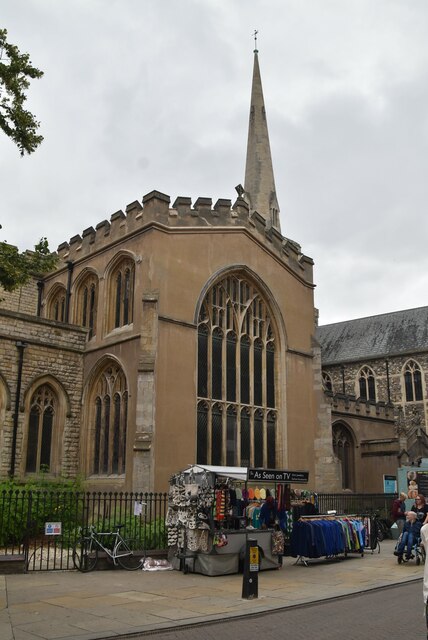2023
TL4458 : Holy Trinity Church
taken 1 year ago, near to Cambridge, Cambridgeshire, England
This is 1 of 16 images, with title Holy Trinity Church in this square

Holy Trinity Church
The first Holy Trinity Church in Cambridge was next to the old Roman road and was just a small thatched timber building. This church burnt down in 1174. In 1189, a new stone church was begun. The stonework of the west wall under the tower is all that remains from the church of this time.
By around 1350, money was raised to widen the nave and add two aisles. In about 1348, a steeple was added to the tower. Around 1400, two transepts were constructed in the Perpendicular style. During the English Reformation (15501750), Holy Trinity Church developed further. In 1616, a gallery was erected along the north side of the nave for the increased size of the congregation.
From 1782 to 1836, Holy Trinity Church was at the centre of spiritual life in Cambridge. The ministry of Charles Simeon (17591836) started when he was appointed vicar by the Bishop of Ely against the wishes of the churchwardens and congregation at the time who disliked his evangelicalism. In 1794, Simeon introduced a barrel organ with sixty hymn tunes into the church. Apart from the repair to the lower section of the steeple in 1824 and painting and varnishing inside the church, Simeon made no structural alterations until 1834. Then the small chancel with 14th century ribbed vaulting was demolished and replaced with the current much larger extension, constructed of brick and plaster.
The church continued to flourish with its evangelistic reputation during Victorian times. In 1887, the chancel was finished in stone, the pews were replaced, choir stalls added and most of the galleries removed. In the same year, the Henry Martyn Memorial Hall was built next to the church as a centre for Christian undergraduates at the University of Cambridge.
Grade II* listed. Link
See other images of Church of The Holy Trinity, Cambridge
By around 1350, money was raised to widen the nave and add two aisles. In about 1348, a steeple was added to the tower. Around 1400, two transepts were constructed in the Perpendicular style. During the English Reformation (15501750), Holy Trinity Church developed further. In 1616, a gallery was erected along the north side of the nave for the increased size of the congregation.
From 1782 to 1836, Holy Trinity Church was at the centre of spiritual life in Cambridge. The ministry of Charles Simeon (17591836) started when he was appointed vicar by the Bishop of Ely against the wishes of the churchwardens and congregation at the time who disliked his evangelicalism. In 1794, Simeon introduced a barrel organ with sixty hymn tunes into the church. Apart from the repair to the lower section of the steeple in 1824 and painting and varnishing inside the church, Simeon made no structural alterations until 1834. Then the small chancel with 14th century ribbed vaulting was demolished and replaced with the current much larger extension, constructed of brick and plaster.
The church continued to flourish with its evangelistic reputation during Victorian times. In 1887, the chancel was finished in stone, the pews were replaced, choir stalls added and most of the galleries removed. In the same year, the Henry Martyn Memorial Hall was built next to the church as a centre for Christian undergraduates at the University of Cambridge.
Grade II* listed. Link
See other images of Church of The Holy Trinity, Cambridge
